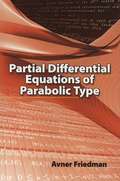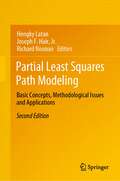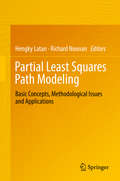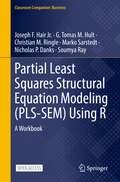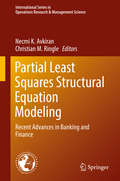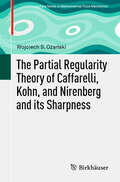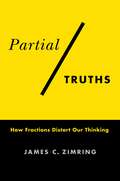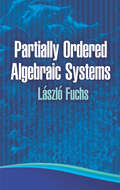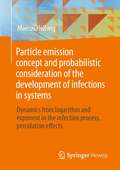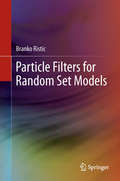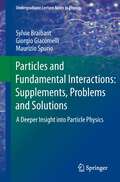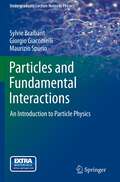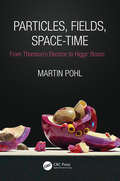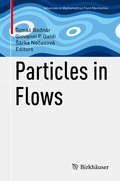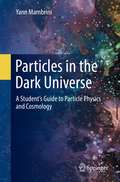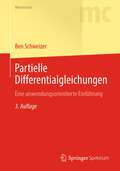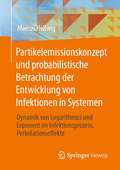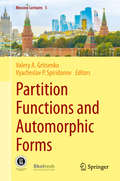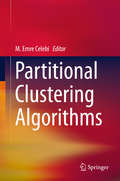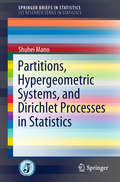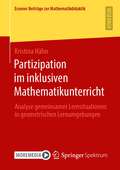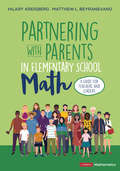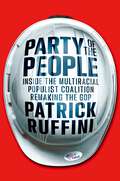- Table View
- List View
Partial Differential Equations of Parabolic Type
by Avner FriedmanThis accessible and self-contained treatment provides even readers previously unacquainted with parabolic and elliptic equations with sufficient background to understand research literature. Author Avner Friedman -- Director of the Mathematical Biosciences Institute at The Ohio State University -- offers a systematic and thorough approach that begins with the main facts of the general theory of second order linear parabolic equations. Subsequent chapters explore asymptotic behavior of solutions, semi-linear equations and free boundary problems, and the extension of results concerning fundamental solutions and the Cauchy problem to systems of parabolic equations. The final chapter concerns questions of existence and uniqueness for the first boundary value problem and the differentiability of solutions, in terms of both elliptic and parabolic equations. The text concludes with an appendix on nonlinear equations and bibliographies of related works.
Partial Least Squares Path Modeling: Basic Concepts, Methodological Issues and Applications
by Hengky Latan Joseph F. Hair Jr. Richard NoonanNow in its second edition, this edited book presents recent progress and techniques in partial least squares path modeling (PLS-PM), and provides a comprehensive overview of the current state-of-the-art in PLS-PM research. Like the previous edition, the book is divided into three parts: the first part emphasizes the basic concepts and extensions of the PLS-PM method; the second part discusses the methodological issues that have been the focus of recent developments, and the last part deals with real-world applications of the PLS-PM method in various disciplines.This new edition broadens the scope of the first edition and consists of entirely new original contributions, again written by expert authors in the field, on a wide range of topics, including: how to perform quantile composite path modeling with R; the rationale and justification for using PLS-PM in top-tier journals; psychometric properties of three weighting schemes and why PLS-PM is a better fit to mode B; a comprehensive review of PLS software; how to perform out-of-sample predictions with ordinal consistent partial least squares; multicollinearity issues in PLS-PM using ridge regression; theorizing and testing specific indirect effects in PLS and considering their effect size; how to run hierarchical models and available approaches; and how to apply necessary condition analysis (NCA) in PLS-PM.This book will appeal to researchers interested in the latest advances in PLS-PM as well as masters and Ph.D. students in a variety of disciplines who use PLS-PM methods. With clear guidelines on selecting and using PLS-PM, especially those related to composite models, readers will be brought up to date on recent debates in the field.
Partial Least Squares Path Modeling
by Hengky Latan Richard NoonanThis edited book presents the recent developments in partial least squares-path modeling (PLS-PM) and provides a comprehensive overview of the current state of the most advanced research related to PLS-PM. The first section of this book emphasizes the basic concepts and extensions of the PLS-PM method. The second section discusses the methodological issues that are the focus of the recent development of the PLS-PM method. The third part discusses the real world application of the PLS-PM method in various disciplines. The contributions from expert authors in the field of PLS focus on topics such as the factor-based PLS-PM, the perfect match between a model and a mode, quantile composite-based path modeling (QC-PM), ordinal consistent partial least squares (OrdPLSc), non-symmetrical composite-based path modeling (NSCPM), modern view for mediation analysis in PLS-PM, a multi-method approach for identifying and treating unobserved heterogeneity, multigroup analysis (PLS-MGA), the assessment of the common method bias, non-metric PLS with categorical indicators, evaluation of the efficiency and accuracy of model misspecification and bootstrap parameter recovery in PLS-PM, CB-SEM, and the Bollen-Stine methods and importance-performance map analysis (IPMA) for nonlinear relationships. This book will be useful for researchers and practitioners interested in the latest advances in PLS-PM as well as master and Ph. D. students in a variety of disciplines using the PLS-PM method for their projects.
Partial Least Squares Structural Equation Modeling: A Workbook (Classroom Companion: Business)
by G. Tomas Hult Marko Sarstedt Christian M. Ringle Joseph F. Hair Jr. Nicholas P. Danks Soumya RayPartial least squares structural equation modeling (PLS-SEM) has become a standard approach for analyzing complex inter-relationships between observed and latent variables. Researchers appreciate the many advantages of PLS-SEM such as the possibility to estimate very complex models and the method’s flexibility in terms of data requirements and measurement specification. This practical open access guide provides a step-by-step treatment of the major choices in analyzing PLS path models using R, a free software environment for statistical computing, which runs on Windows, macOS, and UNIX computer platforms. Adopting the R software’s SEMinR package, which brings a friendly syntax to creating and estimating structural equation models, each chapter offers a concise overview of relevant topics and metrics, followed by an in-depth description of a case study. Simple instructions give readers the “how-tos” of using SEMinR to obtain solutions and document their results. Rules of thumb in every chapter provide guidance on best practices in the application and interpretation of PLS-SEM.
Partial Least Squares Structural Equation Modeling: Recent Advances in Banking and Finance (International Series in Operations Research & Management Science #267)
by Christian M. Ringle Necmi K. AvkiranThis book pulls together robust practices in Partial Least Squares Structural Equation Modeling (PLS-SEM) from other disciplines and shows how they can be used in the area of Banking and Finance. In terms of empirical analysis techniques, Banking and Finance is a conservative discipline. As such, this book will raise awareness of the potential of PLS-SEM for application in various contexts. PLS-SEM is a non-parametric approach designed to maximize explained variance in latent constructs. Latent constructs are directly unobservable phenomena such as customer service quality and managerial competence. Explained variance refers to the extent we can predict, say, customer service quality, by examining other theoretically related latent constructs such as conduct of staff and communication skills. Examples of latent constructs at the microeconomic level include customer service quality, managerial effectiveness, perception of market leadership, etc.; macroeconomic-level latent constructs would be found in contagion of systemic risk from one financial sector to another, herd behavior among fund managers, risk tolerance in financial markets, etc. Behavioral Finance is bound to provide a wealth of opportunities for applying PLS-SEM. The book is designed to expose robust processes in application of PLS-SEM, including use of various software packages and codes, including R. PLS-SEM is already a popular tool in marketing and management information systems used to explain latent constructs. Until now, PLS-SEM has not enjoyed a wide acceptance in Banking and Finance. Based on recent research developments, this book represents the first collection of PLS-SEM applications in Banking and Finance. This book will serve as a reference book for those researchers keen on adopting PLS-SEM to explain latent constructs in Banking and Finance.
The Partial Regularity Theory of Caffarelli, Kohn, and Nirenberg and its Sharpness (Advances in Mathematical Fluid Mechanics)
by Wojciech S. OżańskiThis monograph focuses on the partial regularity theorem, as developed by Caffarelli, Kohn, and Nirenberg (CKN), and offers a proof of the upper bound on the Hausdorff dimension of the singular set of weak solutions of the Navier-Stokes inequality, while also providing a clear and insightful presentation of Scheffer’s constructions showing their bound cannot be improved. A short, complete, and self-contained proof of CKN is presented in the second chapter, allowing the remainder of the book to be fully dedicated to a topic of central importance: the sharpness result of Scheffer. Chapters three and four contain a highly readable proof of this result, featuring new improvements as well. Researchers in mathematical fluid mechanics, as well as those working in partial differential equations more generally, will find this monograph invaluable.
Partial Truths: How Fractions Distort Our Thinking
by James C. ZimringA fast-food chain once tried to compete with McDonald’s quarter-pounder by introducing a third-pound hamburger—only for it to flop when consumers thought a third pound was less than a quarter pound because three is less than four. Separately, a rash of suicides by teenagers who played Dungeons and Dragons caused a panic in parents and the media. They thought D&D was causing teenage suicides—when in fact teenage D&D players died by suicide at a much lower rate than the national average. Errors of this type can be found from antiquity to the present, from the Peloponnesian War to the COVID-19 pandemic. How and why do we keep falling into these traps?James C. Zimring argues that many of the mistakes that the human mind consistently makes boil down to misperceiving fractions. We see slews of statistics that are essentially fractions, such as percentages, probabilities, frequencies, and rates, and we tend to misinterpret them. Sometimes bad actors manipulate us by cherry-picking data or distorting how information is presented; other times, sloppy communicators inadvertently mislead us. In many cases, we fool ourselves and have only our own minds to blame. Zimring also explores the counterintuitive reason that these flaws might benefit us, demonstrating that individual error can be highly advantageous to problem solving by groups. Blending key scientific research in cognitive psychology with accessible real-life examples, Partial Truths helps readers spot the fallacies lurking in everyday information, from politics to the criminal justice system, from religion to science, from business strategies to New Age culture.
Partially Observed Markov Decision Processes
by Vikram KrishnamurthyCovering formulation, algorithms, and structural results, and linking theory to real-world applications in controlled sensing (including social learning, adaptive radars and sequential detection), this book focuses on the conceptual foundations of partially observed Markov decision processes (POMDPs). It emphasizes structural results in stochastic dynamic programming, enabling graduate students and researchers in engineering, operations research, and economics to understand the underlying unifying themes without getting weighed down by mathematical technicalities. Bringing together research from across the literature, the book provides an introduction to nonlinear filtering followed by a systematic development of stochastic dynamic programming, lattice programming and reinforcement learning for POMDPs. Questions addressed in the book include: when does a POMDP have a threshold optimal policy? When are myopic policies optimal? How do local and global decision makers interact in adaptive decision making in multi-agent social learning where there is herding and data incest? And how can sophisticated radars and sensors adapt their sensing in real time?
Partially Ordered Algebraic Systems (Dover Books on Mathematics)
by Laszlo FuchsOriginally published in an important series of books on pure and applied mathematics, this monograph by a distinguished mathematician explores a high-level area in algebra. It constitutes the first systematic summary of research concerning partially ordered groups, semigroups, rings, and fields. The self-contained treatment features numerous problems, complete proofs, a detailed bibliography, and indexes. It presumes some knowledge of abstract algebra, providing necessary background and references where appropriate. This inexpensive edition of a hard-to-find systematic survey will fill a gap in many individual and institutional libraries.
Particle emission concept and probabilistic consideration of the development of infections in systems: Dynamics from logarithm and exponent in the infection process, percolation effects
by Marcus HellwigThe book describes the possibility of making a probabilistic prognosis, which uses the mean n-day logarithm of case numbers in the past to determine an exponent for a probability density for a prognosis, as well as the particle emission concept, which is derived from contact and distribution rates that increase the exponent of the probable development to the extent that a group of people can be formed.
Particle Filters for Random Set Models
by Branko RisticThis book discusses state estimation of stochastic dynamic systems from noisy measurements, specifically sequential Bayesian estimation and nonlinear or stochastic filtering. The class of solutions presented in this book is based on the Monte Carlo statistical method. Although the resulting algorithms, known as particle filters, have been around for more than a decade, the recent theoretical developments of sequential Bayesian estimation in the framework of random set theory have provided new opportunities which are not widely known and are covered in this book. This book is ideal for graduate students, researchers, scientists and engineers interested in Bayesian estimation.
Particles and Fundamental Interactions: Supplements, Problems and Solutions
by Sylvie Braibant Maurizio Spurio Giorgio GiacomelliThis volume is an exercises and solutions manual that complements the book "Particles and Fundamental Interactions" by Sylvie Braibant, Giorgio Giacomelli, and Maurizio Spurio. It aims to give additional intellectual stimulation for students in experimental particle physics. It will be a helpful companion in the preparation of a written examination, but also it provides a means to gaining a deeper understanding of high energy physics. The problems proposed are sometimes true and important research questions, which are described and solved in a step-by-step manner. In addition to the problems and solutions, this book offers fifteen Supplements that give further insight into topical subjects related to particle accelerators, signal and data acquisition systems and computational methods to treat them.
Particles and Fundamental Interactions
by Giorgio Giacomelli Maurizio Spurio Sylvie BraibantThe book provides theoretical and phenomenological insights on the structure of matter, presenting concepts and features of elementary particle physics and fundamental aspects of nuclear physics. Starting with the basics (nomenclature, classification, acceleration techniques, detection of elementary particles), the properties of fundamental interactions (electromagnetic, weak and strong) are introduced with a mathematical formalism suited to undergraduate students. Some experimental results (the discovery of neutral currents and of the W± and Z0 bosons; the quark structure observed using deep inelastic scattering experiments) show the necessity of an evolution of the formalism. This motivates a more detailed description of the weak and strong interactions, of the Standard Model of the microcosm with its experimental tests, and of the Higgs mechanism. The open problems in the Standard Model of the microcosm and macrocosm are presented at the end of the book. For example, the CP violation currently measured does not explain the matter-antimatter asymmetry of the observable universe; the neutrino oscillations and the estimated amount of cosmological dark matter seem to require new physics beyond the Standard Model. A list of other introductory texts, work reviews and some specialized publications is reported in the bibliography. Translation from the Italian Language Edition "Particelle e interazioni fondamentali" by Sylvie Braibant, Giorgio Giacomelli, and Maurizio Spurio Copyright © Springer-Verlag Italia, 2009 Springer-Verlag Italia is part of Springer Science+Business Media All Rights Reserved
Particles, Fields, Space-Time: From Thomson’s Electron to Higgs’ Boson
by Martin PohlCHOICE Highly Recommended 2021Particles, Fields, Space-Time: From Thomson's Electron to Higgs' Boson explores the concepts, ideas, and experimental results that brought us from the discovery of the first elementary particle in the end of the 19th century to the completion of the Standard Model of particle physics in the early 21st century. The book concentrates on disruptive events and unexpected results that fundamentally changed our view of particles and how they move through space-time. It separates the mathematical and technical details from the narrative into focus boxes, so that it remains accessible to non-scientists, yet interesting for those with a scientific background who wish to further their understanding. The text presents and explains experiments and their results wherever appropriate.This book will be of interest to a general audience, but also to students studying particle physics, physics teachers at all levels, and scientists with a recreational curiosity towards the subject.Features Short, comprehensive overview concentrating on major breakthroughs, disruptive ideas, and unexpected results Accessible to all interested in subatomic physics with little prior knowledge required Contains the latest developments in this exciting field
Particles in Flows
by Tomáš Bodnár Giovanni P. Galdi Šárka NečasováThis book aims to face particles in flows from many different, but essentially interconnected sides and points of view. Thus the selection of authors and topics represented in the chapters, ranges from deep mathematical analysis of the associated models, through the techniques of their numerical solution, towards real applications and physical implications. The scope and structure of the book as well as the selection of authors was motivated by the very successful summer course and workshop "Particles in Flows'' that was held in Prague in the August of 2014. This meeting revealed the need for a book dealing with this specific and challenging multidisciplinary subject, i. e. particles in industrial, environmental and biomedical flows and the combination of fluid mechanics, solid body mechanics with various aspects of specific applications.
Particles in the Dark Universe: A Student’s Guide to Particle Physics and Cosmology
by Yann MambriniThis book provides a comprehensive and instructive coverage of particle physics in the early universe, in a logical way. It starts from the thermal history of the universe by investigating some of the main arguments such as Big Bang nucleosynthesis, the cosmic microwave background (CMB) and the inflation, before treating in details the direct and indirect detection of dark matter and then some aspects of the physics of neutrino. Following, it describes possible candidates for dark matter and its interactions.The book is targeted at theoretical physicists who deal with particle physics in the universe, dark matter detection and astrophysical constraints, and at particle physicists who are interested in models of inflation or reheating. This book offers also material for astrophysicists who work with quantum field theory computations. All that is useful to compute any physical process is included: mathematical tables, all the needed functions for the thermodynamics of early universe and Feynman rules. In light of this, this book acts as a crossroad between astrophysics, particle physics and cosmology.
Partielle Differentialgleichungen: Eine anwendungsorientierte Einführung (Masterclass)
by Ben SchweizerDas Buch führt in die Theorie der Partiellen Differentialgleichungen ein, lediglich die Grundvorlesungen der Analysis werden vorausgesetzt. Eine Vielzahl linearer und nichtlinearer Differentialgleichungen wird mit Modellierungsansätzen motiviert und rigoros analysiert. Nach den klassischen linearen Problemen der Potentialtheorie und Wärmeleitung werden insbesondere nichtlineare Probleme aus der Theorie poröser Medien, der Strömungsmechanik und der Festkörpermechanik behandelt. Entlang der Aufgabenstellungen von zunehmender Komplexität werden moderne Methoden und Theorien der Analysis entwickelt.Für die vorliegende 3. Auflage wurde der Text überarbeitet und korrigiert, an vielen Stellen wurden Beweisabläufe optimiert und Motivationstexte eingebaut. An anderen Stellen inhaltlich ausgedünnt und verkürzt, um den Vorlesungsumfang nicht zu sprengen.
Partikelemissionskonzept und probabilistische Betrachtung der Entwicklung von Infektionen in Systemen: Dynamik von Logarithmus und Exponent im Infektionsprozess, Perkolationseffekte
by Marcus HellwigDas Buch beschreibt die Möglichkeit, eine probabilistische Prognose zu erstellen, die den mittleren n-Tage-Logarithmus von Fallzahlen in der Vergangenheit verwendet, um einen Exponenten für eine Wahrscheinlichkeitsdichte für eine Prognose zu bestimmen, als auch das Partikelemissionskonzept, das sich herleitet aus Kontakt- und Verteilungsrate, welche den Exponenten der voraussichtlichen Entwicklung in dem Maß erhöht wie sich eine Gruppenbildung von Personen bilden kann.
Partition Functions and Automorphic Forms (Moscow Lectures #5)
by Valery A. Gritsenko Vyacheslav P. SpiridonovThis book offers an introduction to the research in several recently discovered and actively developing mathematical and mathematical physics areas. It focuses on: 1) Feynman integrals and modular functions, 2) hyperbolic and Lorentzian Kac-Moody algebras, related automorphic forms and applications to quantum gravity, 3) superconformal indices and elliptic hypergeometric integrals, related instanton partition functions, 4) moonshine, its arithmetic aspects, Jacobi forms, elliptic genus, and string theory, and 5) theory and applications of the elliptic Painleve equation, and aspects of Painleve equations in quantum field theories. All the topics covered are related to various partition functions emerging in different supersymmetric and ordinary quantum field theories in curved space-times of different (d=2,3,…,6) dimensions. Presenting multidisciplinary methods (localization, Borcherds products, theory of special functions, Cremona maps, etc) for treating a range of partition functions, the book is intended for graduate students and young postdocs interested in the interaction between quantum field theory and mathematics related to automorphic forms, representation theory, number theory and geometry, and mirror symmetry.
Partitional Clustering Algorithms
by M. Emre CelebiThis book focuses on partitional clustering algorithms, which are commonly used in engineering and computer scientific applications. The goal of this volume is to summarize the state-of-the-art in partitional clustering. The book includes such topics as center-based clustering, competitive learning clustering and density-based clustering. Each chapter is contributed by a leading expert in the field.
Partitions, Hypergeometric Systems, and Dirichlet Processes in Statistics (SpringerBriefs in Statistics #0)
by Shuhei ManoThis book focuses on statistical inferences related to various combinatorial stochastic processes. Specifically, it discusses the intersection of three subjects that are generally studied independently of each other: partitions, hypergeometric systems, and Dirichlet processes. The Gibbs partition is a family of measures on integer partition, and several prior processes, such as the Dirichlet process, naturally appear in connection with infinite exchangeable Gibbs partitions. Examples include the distribution on a contingency table with fixed marginal sums and the conditional distribution of Gibbs partition given the length. The A-hypergeometric distribution is a class of discrete exponential families and appears as the conditional distribution of a multinomial sample from log-affine models. The normalizing constant is the A-hypergeometric polynomial, which is a solution of a system of linear differential equations of multiple variables determined by a matrix A, called A-hypergeometric system. The book presents inference methods based on the algebraic nature of the A-hypergeometric system, and introduces the holonomic gradient methods, which numerically solve holonomic systems without combinatorial enumeration, to compute the normalizing constant. Furher, it discusses Markov chain Monte Carlo and direct samplers from A-hypergeometric distribution, as well as the maximum likelihood estimation of the A-hypergeometric distribution of two-row matrix using properties of polytopes and information geometry. The topics discussed are simple problems, but the interdisciplinary approach of this book appeals to a wide audience with an interest in statistical inference on combinatorial stochastic processes, including statisticians who are developing statistical theories and methodologies, mathematicians wanting to discover applications of their theoretical results, and researchers working in various fields of data sciences.
Partizipation im inklusiven Mathematikunterricht: Analyse gemeinsamer Lernsituationen in geometrischen Lernumgebungen (Essener Beiträge zur Mathematikdidaktik)
by Kristina HähnKristina Hähn untersucht Verläufe gemeinsamer Lernsituationen im inklusiven Mathematikunterricht und damit verbundene individuelle Partizipationsprozesse von Schülerinnen und Schülern mit dem sonderpädagogischen Unterstützungsbedarf im Lernen. Das gemeinsame Lernen an einem gemeinsamen Gegenstand wird durch Lernumgebungen zum Thema ‚Kreis‘ herausgefordert, die im Sinne des Prinzips der natürlichen Differenzierung entwickelt wurden. Die Ergebnisse der Untersuchung stützen theoretische Überlegungen zum Mehrwert einer Vielfalt gemeinsamer Lernsituationen im inklusiven Unterricht. Darüber hinaus führen sie zu Folgerungen für die Konzeption und den Einsatz substanzieller Lernumgebungen mit dem Ziel, die produktive Beteiligung aller Lernenden am inklusiven Mathematikunterricht zu erhöhen und Partizipationsbarrieren abzubauen.
Partnering With Parents in Elementary School Math: A Guide for Teachers and Leaders (Corwin Mathematics Series)
by Hilary L. Kreisberg Matthew L. BeyranevandHow to build productive relationships in math education I wasn’t taught this way. I can’t help my child! These are common refrains from today’s parents and guardians, who are often overwhelmed, confused, worried, and frustrated about how to best support their children with what they see as the "new math." The problem has been compounded by the shift to more distance learning in response to a global pandemic. Partnering With Parents in Elementary School Math provides educators with long overdue guidance on how to productively partner and communicate with families about their children’s mathematics learning. It includes reproducible surveys, letters, and planning documents that can be used to improve the home-school relationship, which in turn helps students, parents, teachers, and education leaders alike. Readers will find guidance on how to: · Understand and empathize with what fuels parents’ anxieties and concerns · Align as a school and set parents’ expectations about what math instruction their children will experience and how it will help them · Communicate clearly and productively with parents about their students’ progress, strengths, and needs in math · Run informative and fun family events · support homework · Coach parents to portray a productive disposition about math in front of their children Educators, families, and students are best served when proactive, productive, and healthy relationships have been developed with each other and with the realities of today′s math education. This guide shows how these relationships can be built.
Partnering With Parents in Elementary School Math: A Guide for Teachers and Leaders (Corwin Mathematics Series)
by Hilary L. Kreisberg Matthew L. BeyranevandHow to build productive relationships in math education I wasn’t taught this way. I can’t help my child! These are common refrains from today’s parents and guardians, who are often overwhelmed, confused, worried, and frustrated about how to best support their children with what they see as the "new math." The problem has been compounded by the shift to more distance learning in response to a global pandemic. Partnering With Parents in Elementary School Math provides educators with long overdue guidance on how to productively partner and communicate with families about their children’s mathematics learning. It includes reproducible surveys, letters, and planning documents that can be used to improve the home-school relationship, which in turn helps students, parents, teachers, and education leaders alike. Readers will find guidance on how to: · Understand and empathize with what fuels parents’ anxieties and concerns · Align as a school and set parents’ expectations about what math instruction their children will experience and how it will help them · Communicate clearly and productively with parents about their students’ progress, strengths, and needs in math · Run informative and fun family events · support homework · Coach parents to portray a productive disposition about math in front of their children Educators, families, and students are best served when proactive, productive, and healthy relationships have been developed with each other and with the realities of today′s math education. This guide shows how these relationships can be built.
Party of the People: Inside the Multiracial Populist Coalition Remaking the GOP
by Patrick RuffiniAn eye-opening, revelatory account of the future of the Republican party as they unite working-class voters in a multi-racial, cross-generational populist coalition.Donald Trump&’s victory in the 2016 presidential election shocked the world. Yet his defeat in 2020 may have been even more surprising: he received 12 million more votes in 2020 than 2016 and his unexpectedly diverse coalition included millions of nonwhite voters, a rarity for the modern Republican party. In 2020, Trump defied expectations and few journalists, strategists, or politicians could explain why Trump had nearly won reelection. Patrick Ruffini, a Republican pollster and one of the country&’s leading experts on political targeting, technology, and demography, has the answers—and the explanation may surprise you. For all his apparent divisiveness, Trump assembled the most diverse Republican presidential coalition in history and rode political trends that will prove significant for decades to come. The shift is profound: seven in ten American voters belong to groups that have shifted right in the last two presidential elections, while under three in ten whites with a college degree belong to groups that are trending left. Together, this super-majority of right-trending voters forms a colorblind, populist coalition, largely united by its working-class roots, moderate to conservative views on policy, strong religious beliefs, and indifference to or outright rejection of the identity politics practiced by the left. Not all these voters are Republican, and in certain corners of the coalition, only a small minority are. But recent elections are pointing us towards a future where party allegiances have been utterly upended. The Party of the People demonstrates this data. Ruffini was as wrong as every pollster in 2016 and spent the intervening years figuring out why and developing better methods of analyzing voters in the digital age. Using robust data, he shifts you away from the complacent, widespread narrative that the Republican party is a party of white, rural voters. It is, but more importantly for its longevity, it&’s a party of non-college educated voters. And as fewer voters attend college, the Republican party shows no signs of stagnation. With rich data and clear analysis, Party of the People explains the present and future of the Republican party and American elections.
